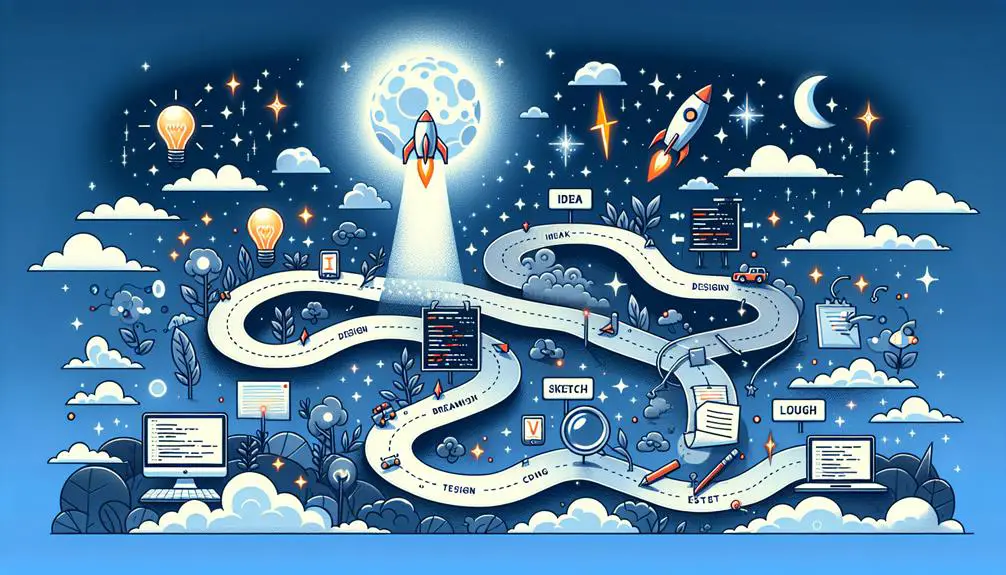Embarking on the journey to build your first SaaS MVP is like navigating through uncharted waters; it's thrilling yet fraught with uncertainties. You've got an idea that could disrupt the market, but turning that spark into a functional and scalable product requires more than just enthusiasm.
You'll need to sift through market analysis, pin down your design, choose your technology stack wisely, and iterate rapidly based on user feedback. This guide lays down the stepping stones for turning your vision into reality, without getting lost at sea.
Let's explore how to avoid common pitfalls and set sail towards success, leaving you curious about the strategies that could make or break your venture.
Contents
Key Takeaways
- Conduct thorough market analysis to ensure your MVP meets real customer needs and stands out from competitors.
- Prioritize design and user experience to create a seamless and intuitive product.
- Choose a technology stack that supports scalability, security, and future growth.
- Establish a feedback loop for continuous improvement based on user insights and data protection best practices.
Market Analysis
To kick off your SaaS MVP journey, diving into market analysis is key to uncovering what your future customers truly need. This isn't just about skimming the surface; it's about deep, insightful understanding of your target audience. Through meticulous market research, you'll identify not just the obvious, but the nuanced pain points and needs that drive your potential users. It's this customer-centric approach that will set the foundation for your MVP development.
But market analysis isn't just about understanding your customer. It's also about getting a clear view of the landscape you're entering. You need to know the market trends shaping the future of SaaS products and the competition you're up against. This doesn't mean you should mimic what's already out there. Instead, use this knowledge to innovate, to find your unique value proposition that speaks directly to your target audience's needs. By aligning your MVP development with these insights, you're not just building a product; you're crafting a solution that resonates, engages, and ultimately, succeeds in a crowded marketplace.
Idea Verification
After understanding your market, it's crucial you validate your product idea through thorough research and feedback. Idea verification is your golden ticket to ensuring your SaaS product concept isn't just good on paper but has real-world applicability and demand. This step is about more than just ticking boxes; it's about engaging deeply with your potential users and market to save time and money by focusing on what truly matters.
To navigate this process effectively, consider these steps:
- Conduct Competitor Analysis: Understand what's already out there. This helps you identify gaps your MVP could fill.
- Engage with Potential Customers: Through polls and interviews, gather insights on the problem you're aiming to solve.
- Validate the Solution: Ensure your proposed solution effectively addresses the problems identified by your target audience.
- Iterate Based on Feedback: Use early feedback to refine your concept before committing to full-scale development.
Design and Wireframing

Moving into the design and wireframing phase, you'll start transforming your MVP's concept into tangible blueprints that guide its development. This step is crucial as it lays down the visual groundwork of your SaaS MVP, focusing on the layout, features, and the overall user experience. You're not just drawing pictures; you're crafting the foundation of how your MVP will interact with its users.
| Design Phase | Purpose |
|---|---|
| Wireframing | To outline the structure and functionality of your MVP, ensuring that the layout aligns with user needs and product requirements. |
| User Interface Design | To create a seamless and intuitive experience, making sure that the design elements contribute to easy navigation. |
| Layout Planning | To strategically place features in a way that promotes usability and enhances the overall flow of the application. |
| Feature Visualization | To visually present how each feature will function and integrate with other parts of the MVP. |
| Alignment with User Needs | To ensure that every aspect of the design is centered around meeting user expectations and solving their problems effectively. |
Technology Stack Selection
Having established a solid visual foundation for your SaaS MVP, it's now critical to select the right technology stack that will bring your designs to life. The tech stack you choose is more than just a set of tools; it's the backbone of your product, affecting not only its current performance but also its future growth and adaptability.
Here's a four-step guide to make your selection process smoother:
- Assess Scalability Needs: Your tech stack should grow with your MVP. Opt for technologies known for scalability to ensure your product can handle increasing loads without a hitch.
- Prioritize Security: Security breaches can be detrimental. Select frameworks and programming languages with strong security features and good reputations.
- Consider Future Integrations: Your MVP will need to play nice with other services. Choose a technology stack that offers compatibility and ease of integration with essential tools and services.
- Focus on Long-Term Growth: Think beyond the MVP launch. Your chosen tech stack should support long-term growth, allowing for easy updates and the addition of new features without a complete overhaul.
Choosing the right technology stack—considering scalability, security, integrations, and long-term growth—sets the stage for your MVP's success.
Development and Testing

Once you've selected the ideal technology stack, it's time to dive into the development and testing phase of your SaaS MVP. Agile practices should guide your journey, ensuring flexibility and efficiency. Start with early testing and frequent code reviews to catch issues before they escalate.
| Stage | Focus |
|---|---|
| Development | Building features using your technology stack, implementing agile practices for flexibility. |
| Early Testing | Conducting code reviews and initial tests to identify issues early. |
| Functional Testing | Ensuring each feature works as intended, critical for user satisfaction. |
| User Acceptance Testing | Getting real users to test the MVP, invaluable for gathering first-hand feedback. |
| Performance Evaluation | Assessing the MVP's stability and scalability under load. |
Feedback and Iteration
Once your MVP is out there, it's crucial you listen to what users are saying. Their feedback will guide you in tweaking your product to better meet their needs.
This iterative process of refining, based on real-world insights, is key to making your SaaS MVP a success.
Gathering User Insights
To refine your SaaS MVP and align it with user needs, it's crucial to actively gather and incorporate user feedback into your development process. Here's how you can effectively do this:
- Conduct User Interviews: Direct conversations provide deep insights into user preferences and pain points.
- Deploy Surveys: Quick, scalable way to collect quantitative data on user needs and satisfaction.
- Implement Analytics: Understand how users interact with your MVP, identifying areas for enhancement.
- Create a Feedback Loop: Establish a system for continuous feedback collection and iteration, ensuring a user-centric refinement process.
Iterative Product Refinements
Diving into iterative product refinements means you'll be leveraging user feedback to continuously polish your SaaS MVP. This feedback-driven iteration is your toolkit for aligning closely with user needs, ensuring that every tweak and adjustment brings you closer to the ideal user experience.
By focusing on real-time user insights, you're not just guessing what works; you're applying concrete data to drive your decision-making process. This approach allows for the fine-tuning of features, making sure every element of your MVP is optimized.
Data Protection Strategies

When building your first SaaS MVP, you can't ignore the importance of encryption best practices and regular security audits. These strategies not only protect your user's data but also build trust in your product.
Encryption Best Practices
In today's digital age, implementing encryption best practices is essential for safeguarding your SaaS MVP's sensitive data against unauthorized access and breaches. Here's how you can do it:
- Use Strong Encryption Algorithms: Opt for industry-standard algorithms like AES to ensure the highest level of data security in your SaaS applications.
- Implement Encryption Key Management: Securely store and manage encryption keys to prevent unauthorized access and ensure only authorized personnel can decrypt sensitive data.
- Ensure Compliance: Stay updated with regulations such as GDPR to ensure your encryption practices meet legal requirements.
- Encrypt Data at Rest and in Transit: This protects your sensitive data from unauthorized access, whether it's stored on your servers or transmitted over the internet.
Embrace these strategies to maintain the integrity, confidentiality, and availability of your data.
Regular Security Audits
After ensuring your SaaS MVP's data is protected with strong encryption practices, it's equally important to regularly audit your security measures to catch any vulnerabilities early on.
Regular security audits are crucial, not just a checkbox exercise. Conducting these audits shines a light on any weaknesses in your security infrastructure, allowing you to address them before they become gateways for data breaches.
Remember, the stakes are high; a single breach can severely dent your reputation and trust with users. Furthermore, audits are your best tool in maintaining compliance with strict regulations like GDPR and CCPA, safeguarding customer data.
User Onboarding and Support
How do you ensure your users not only sign up but also stick around and become long-term customers? The key lies in crafting an effective user onboarding and support strategy. Let's dive into how you can achieve this:
- Implement Mobile-Friendly Onboarding: Given that 52% of users expect a mobile-friendly experience, ensure your onboarding process is optimized for mobile. This step is crucial in increasing product adoption and customer satisfaction.
- Personalize the Onboarding Experience: A personalized onboarding process can boost customer satisfaction by 30%. Use data to tailor the onboarding journey for each user, making it more relevant and engaging.
- Offer Comprehensive User Support: User support goes hand in hand with onboarding. Providing robust support can reduce customer churn rates by 70%. Make sure your users have easy access to help when they need it.
- Focus on Effective User Onboarding: An effective onboarding process can increase product adoption by 50% and make users 4 times more likely to become long-term customers. Invest time in refining your onboarding strategy to ensure it's clear, engaging, and simplified.
Frequently Asked Questions
How Do I Create an MVP for a Saas Startup?
To create an MVP for a SaaS startup, you'll first conduct market research, define a value proposition, map the user flow, develop essential features, and then test it with a small group for feedback.
How Do You Build an MVP Step by Step?
Ironically, building an MVP is simple, right? Just dive in! First, identify customer pains, then outline your value. Design a smooth user flow, develop with essential features, test, and iterate. You're mastering the art already!
How Long Does It Take to Build a Saas Mvp?
You'll typically spend 3 to 6 months building your SaaS MVP. This time varies based on its complexity and the features you're including. It's a process of design, development, testing, and refining based on feedback.
What Are the Stages of Startup Mvp?
Imagine launching a revolutionary app. You'd start by researching the market, defining your unique offer, designing a smooth user experience, developing key features, and testing with early users to refine your product. That's your MVP journey.


